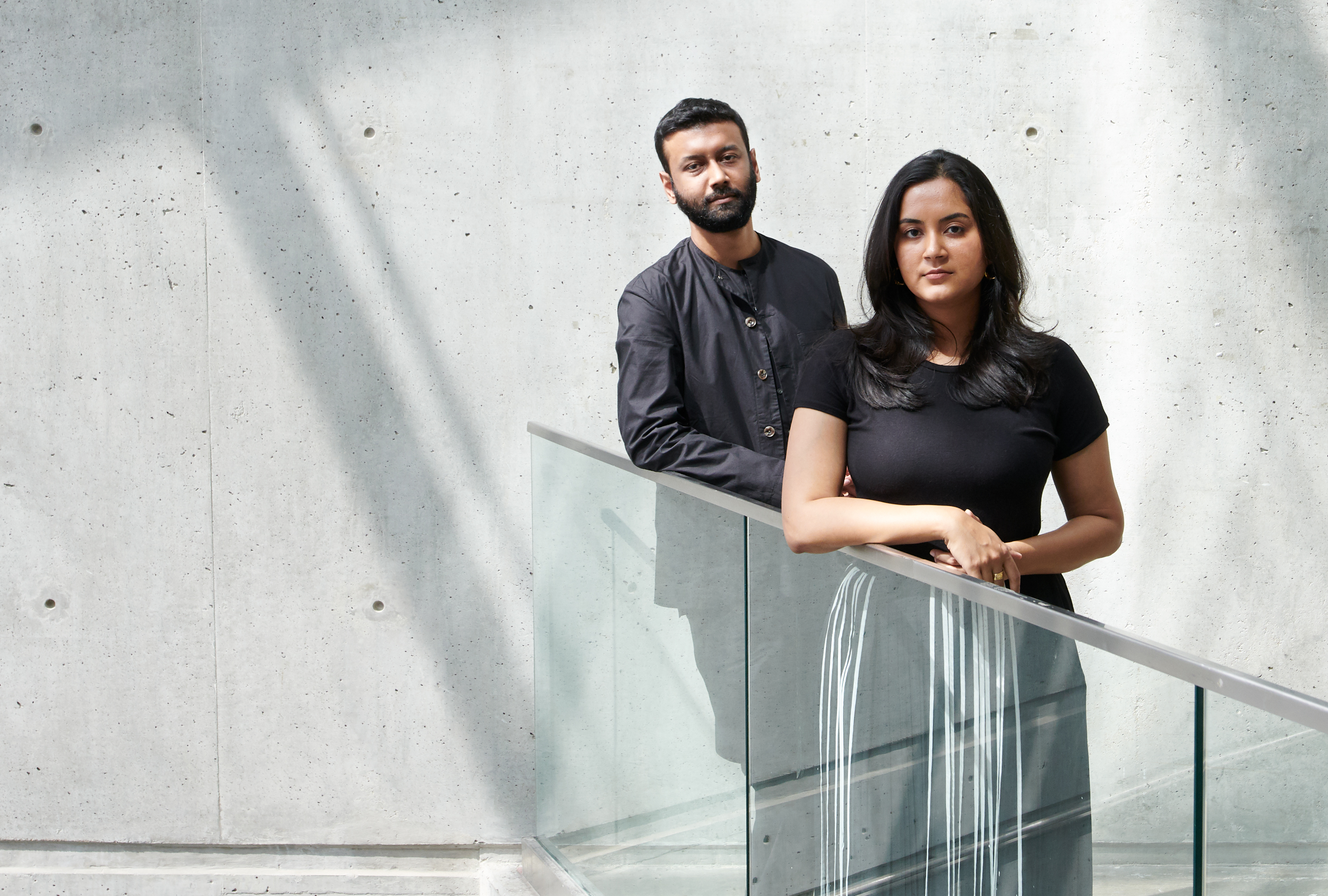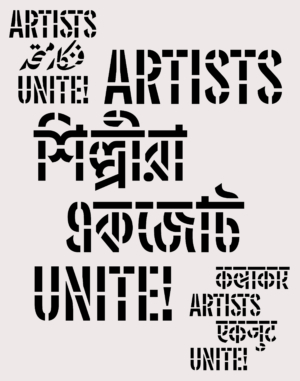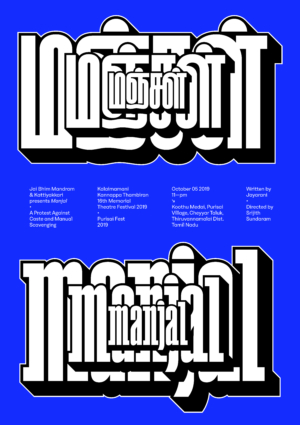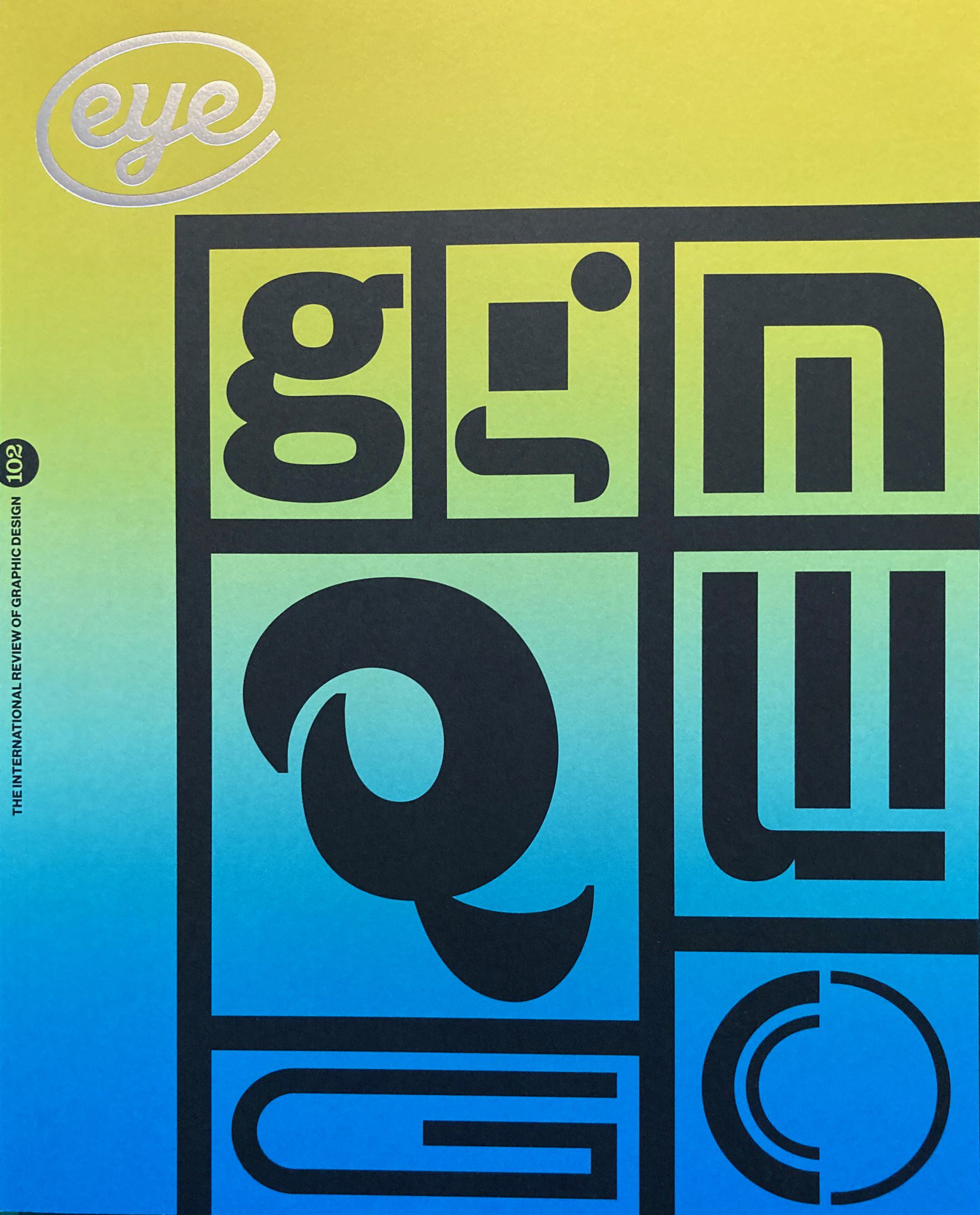Autumn 2021
Design for a better world
November
Shiva Nallaperumal
Juhi Vishnani
Arya Purohit
Hitesh Malaviya
Rendani Nemakhavhani
Indian design duo November balances commercial practice with a commitment to social change. By John L. Walters

November is a Mumbai design duo, founded by Shiva Nallaperumal and Juhi Vishnani, that is both intellectually driven and commercially astute. Type is at the heart of November, and the practice works across many different languages and scripts. Their portfolio spans editorial design, branding and identity, logotypes, illustration, motion graphics, music design, typeface design and social activism. And they have strong views about justice, society and the prevailing political and social climate – they have lent their design skills to many social causes during these challenging times.
Nallaperumal and Vishnani met and became a couple as undergraduates at DJ Academy of Design in Othakalmandapam, in the city of Coimbatore, Tamil Nadu. They went overseas for postgraduate studies – Nallaperumal to Baltimore’s Maryland Institute College of Art (Mica) in the US and Vishnani to Chelsea College of Arts in the UK. ‘It was a big change from the rather isolated design school we went to previously,’ says Vishnani.
When they returned to India in the mid 2010s, both worked within the design industry. Nallaperumal concentrated on typeface design, while Vishnani joined TSK Design (run by Tania Singh Khosla) in Bangalore, where the small team meant she was soon given big responsibilities. ‘There was very little hierarchy and Tania was a nurturing guide,’ says Vishnani. ‘There are so many holes in design education when it comes to the actual doing of it: pitching, working with clients, financial management, legalities, managing teams, working across verticals, etc.’ She eventually moved back to Mumbai to work for Landor, where ‘everything was different: the pace, the scale, the process.’ Vishnani worked on projects for consumer products, financial institutions and pharmaceuticals.
They launched November in 2018. ‘When we started, we were fortunate to get steady work immediately,’ says Nallaperumal. His published typefaces had attracted attention, as had their more visible work in music, art and publishing. The newly launched November studio soon built up an impressive roster of clients, including the American NBA (National Basketball Association), Red Bull Music, Wolff Olins, Kyoorius, publishers such as Navayana (in Delhi) and Tara Books, publications Elle and The New York Times Book Review (editorial spot illustrations) and a well known, secretive Silicon Valley behemoth fond of NDAs. They chose to remain small, with just one junior, and called upon a roster of friends and collaborators on a project-by-project basis: animators, photographers, illustrators and type designers.
Indian script complexities
Early on, November was commissioned (by Fitch Mumbai) to make a logotype in seven different Indian scripts (Devanagari, Tamil, Malayalam, Odia, Bangla, Telugu and Kannada) for Domino’s Pizza in collaboration with Arya Purohit and Hitesh Malaviya. ‘We matched the soft, bulbous details of the Latin logo with the complexities of Indian letterforms,’ says Nallaperumal. His type design skills have led them to collaborate with (and sell fonts via) several international type foundries, including Typotheque, Sharp Type, Bold Monday and Lost Type Co-op.
‘Shiva and Juhi’s work is contemporary and stylish with deep underpinnings in both western and Indian design history,’ says Commercial Type’s Christian Schwartz. ‘Their eclectic taste in visual culture really resonates with me.’
One substantial commission, currently in development, is a set of complete type families for a very well known global app, in seven scripts, 56 fonts in total, though this project has been delayed by the economic effects of the Covid-19 pandemic.
The practice’s editorial design has spanned the art direction of the Journal of the Indian Institute of Architects (JIIA), political non-fiction books and other materials for Navayana Publishing and the logo for fashion and youth culture magazine Dirty. November’s identity for the independent fashion label Bodice was based around a custom typeface, and the studio designed all the print materials, including swing tags, lookbooks and stationery. They consider themselves lucky to have worked with a diverse clientele, which has helped them gain experience of a broad span of industries, audiences and cultures. In 2019 Nallaperumal – representing both principals – was inducted into AGI (Alliance Graphique Internationale).
The Artists Unite project, a coming together of artists and writers to protest the politics of hate, took place before the 2019 elections in India. November designed a stencil typeface, together with a logotype in multiple scripts, for the cultural movement to use as a ‘toolkit’ for posters and signs.
‘All they had to do was to use the Artists Unite typeface – to write anything, really – and it would be identifiable,’ says Nallaperumal. The font (in Latin only) comes with the heartfelt command: ‘This typeface is for use only for anti-fascist purposes and not to be used for commercial purposes.’
When Nallaperumal speaks, theories, ideas and statements tumble out with huge enthusiasm. ‘I’ve always looked at design as a tool, as my way of engaging with the world, and not really as an end in itself. I was interested in cinema, fashion, politics.’ He reads extensively; favourite books include the Experimental Jetset monograph Statement and Counter-Statement (see Eye 92) and Design Writing Research by Ellen Lupton and Abbott Miller. ‘Some of my favourite designers are very good writers,’ he says. He has little time for what he calls ‘printed Behance-style’ books – design books ‘that just print images of projects without any writing – theory or context.’
Vishnani’s and Nallaperumal’s skills are complementary. They explain that the former is more ‘client-facing’, focused on art direction and strategy, while the latter is ‘more on the technical side of things’ or ‘nerdier’. A collaboration that uses all their skills is Singing / Thinking Anti-Caste (2021), a book of essays on anti-caste music by publisher Yogesh Maitreya, which the duo designed and typeset, making all its distinctive linocut illustrations.
Nallaperumal explains: ‘Juhi was the lino expert, she’s very much into material processes; she has experimented with marbling paper. I would illustrate and she would convert that into linoprints and then we would scan it back and put it in the book.’
Vishnani and Nallaperumal feel obliged to point out that they are from ‘the oppressor caste’, so their role in anti-caste projects is that of ‘useful allies’, working alongside artists and practitioners from the oppressed castes. An important function performed by anti-caste artists is to educate people about rights they may not even know they have. Music, explains Nallaperumal, is one of the most powerful ways to do this, even though the bands do not have access to mainstream concert spaces or venues. They have to make their own.
‘Publishing has been at the forefront of the movement since its inception,’ says Nallaperumal, citing the importance of anti-caste publishers Navayana (founded 2003) and Maitreya’s Panther’s Paw Publication (founded 2016 in Nagpur). November’s digital cover artwork for anti-caste band Casteless Collective shows the band destroying a ‘caste pyramid’, a symbol of hierarchy and oppression.
Maitreya, a member of India’s Dalit community, explains that Panther’s Paw’s philosophy is not just ‘to publish anti-caste literature or oppressed caste authors into English, but to introduce them to the world.’ His aim is to spread the anti-caste consciousness ‘so we may have some global solidarity in the future.’ The imprint takes its name from the Dalit Panthers, a 1970s organisation inspired by the Black Panthers.
To promote Navayana’s book Now It’s Come to Distances (2020) by Marxist philosopher Soumyabrata ‘Shomo’ Choudhury, November designed posters that interpreted excerpts from the book. November stated on Instagram that ‘the posters sought to visualise the uncomfortable, droning fear and uncertainty of the past year … stripping graphic design to its bare essence: colour, form and abstraction.’
Asked whether the studio’s interest in political projects jeopardises their ability to win clients, Vishnani says that every act is political, so ‘every designer is a political designer’. However, she observes that this is a difficult line to walk and that some studios are more at risk than others. ‘We live under a capitalist system and the constraints are inevitable,’ she says, ‘and being able to say no to paying work is an extremely privileged position, you know? Add to that the cost of design education, student loans and costs of living in design hubs and we have a bleak picture where “choice” becomes hard to exercise for most designers.’
Decolonisation or pluralism?
Language – and consequentially type and typography – underpins everything November does. I ask them to describe the ever-growing Indian design scene for outsiders. ‘In a general sense it is pretty globalised, with corporate, tech start-up and branding work taking precedence,’ says Nallaperumal. For Vishnani, the greatest challenge is to find one’s own identity within design: ‘We live in a super globalised world of over stimulation – we consume more design / inspiration / work than we produce. We need to find our own grammar to express our points of views visually in the plethora of projects we work on. The work, client, context will be different each time, so the question is: where are you in your work?’
‘India is the most linguistically diverse nation in the world,’ says Nallaperumal, ‘so this obviously has a huge impact on the design scene. Design for publishing and cinema especially are filled with coded cultural influences unique to each language and culture. For example, the design of Bengali film posters is distinctly different from design for Tamil cinema.’
The criss-crossing of language and culture infuses many of November’s projects. For instance, Vishnani’s lettering for a collaboration with South African designer Rendani Nemakhavhani for Design Across Borders is ‘ghar’, the Arabi-Sindhi word for home, rendered like elegant barbed wire. Vishnani’s grandparents migrated from Sindh (now part of Pakistan) during the 1947 partition of India.
Asked whether ‘decolonising design’ is a useful term, Nallaperumal is circumspect: ‘It is a nuanced topic,
and the theory is still developing, but the basic idea is to shift ideas of what is acceptable, aesthetic, beautiful or functional from a western-centric perspective to a more contextual one, and to bring pluralistic ideas to the world stage. Some argue that precolonial times were Utopian and that we should aim to go back there, which is mostly a right-wing / nationalist stance that we don’t agree with.
‘“Decolonisation” cannot be a movement with a single definition, and we look forward to engaging with the developing discourse around this topic. For ourselves, we prefer the term “pluralism”, which is why we call ourselves a “plural practice”. It’s inclusive and looks firmly to the future, addressing history along the way.’
Speak with one voice
Nallaperumal explains that his interest in type was sparked by Tamil comic books, Indian film titles and band logos.
‘When the computer came as this new design tool, it was mainly Latin-focused. In India, the computer constrained people because there were not many typeface options. Most letterers were also illustrators, so they would illustrate short stories that would appear in the magazines, and the type would be part of that illustration. That was definitely a massive influence, in terms of how free letters can be.’
When Nallaperumal first went to design school, he wanted to make comic books with speech bubbles: ‘I didn’t know what graphic design was!’
Nallaperumal cites his graduate type design classes at Mica with Tal Leming as a turning point: ‘That was the biggest impact a teacher ever had on me. Tal taught me type design, software, and basically the history of type.’ This connection with Leming, a popular and influential figure who runs the foundry Type Supply, and who invented much of the software that underpins contemporary type design, led to many other connections. Leming introduced Nallaperumal to Commercial Type’s Christian Schwartz. When the NBA (National Basketball Association) went to India and needed its branding localised in Indian languages, November made it happen. For Nallaperumal this was a dream come true. ‘Christian is one of my heroes and I’ve followed his career, almost like a rock band! I’ve always wanted to publish with Commercial Type.’
Nallaperumal’s ingenious display typeface Calcula (2017) started life as a final assignment in his typeface design class with Leming at Mica. However, his most ambitious typeface is perhaps Oli Grotesk (2019), published, like Calcula, by Typotheque. Though Oli is so far only available in Latin, Nallaperumal intends that the typeface should support nine Indic scripts – Devanagari, Bangla, Gujarati, Gurmukhi, Odia, Tamil, Malayalam, Telugu and Kannada – in the same range of weights as the original, so that it can ‘speak all of India’s languages with the same voice’. Nallaperumal’s college friend and fellow type designer Arya Purohit is currently working on the Indic versions, with Devanagari promised in the near future.
Asked to name other designers admired by November, a mix of independently minded studios and individuals pops up: Peter Saville, Karel Martens, Richard Turley, Peter & Johanna Biľak’s Typotheque and Metahaven, plus comic book
legend Orijit Sen (whose handwriting November has made into a typeface), architecture studio The Busride and illustrators Siddhesh Gautam, Madhav Nair and Somnath Bhatt.
Conversations between Eye and November took place at a time of big personal and professional change. Just before the global pandemic hit India, Nallaperumal describes experiencing a ‘crippling lull’, feeling too uninspired to embark on personal projects in the absence of commercial work. ‘We were not watching many films, reading, drawing or exploring music, all the things we do that feed our creative pursuits. Added to that was the fear and concern for the wellbeing of our family and friends, the continued decay of our nation’s health infrastructure and unempathetic governmental policies.’
Breathing space
In early 2021 Mica, Nallaperumal’s alma mater, called for applications to their new ‘designer in residence’ programme. Nallaperumal ‘instinctively’ applied and was accepted. In the summer of 2021, Vishnani and Nallaperumal bid a temporary farewell to Mumbai and moved to Baltimore for a year.
After three busy years, they regard the relocation as a kind of ‘sabbatical’, in which they can teach, work on personal projects and develop typefaces. (Nallaperumal has ‘folders and folders of unfinished typefaces’.) Vishnani has enjoyed observing and discussing her partner’s graduate type design class at home, having never tried her hand at type design before. ‘I love slow, meditative processes and endlessly refining work, but at the same time I’m impatient for results,’ she says. ‘Designing type seems kind of perfect! It’s a long meditative process that also gives you immediate results!’
Christian Schwartz has been working with November on a typeface called Diplomat, which they will use as the sole typeface for their new website. Other projects in train include an interpretation of Times New Roman plus international commissions still constrained by NDAs at the time of publication. In addition, November are continuing to work for several clients back home in India, including Navayana and Panther’s Paw Publication, and some fashion and lifestyle brands.
Talking about their ambitions for the future, Vishnani says they have always wanted to work on projects in which they are involved from beginning to end. Their dream project, influenced by Tibor Kalman’s Colors (see Eye 20), is to create a magazine from scratch. ‘I’ve always wanted to do that,’ Vishnani declares, ‘to create a complete work. We have a great idea for a magazine but need to find someone interested in funding and publishing it!’
Multilingualism and globalisation
Asked how he views the challenges of type design for Indian languages, Nallaperumal replies: ‘India’s design is highly divided on a linguistic basis. Because of our colonial past and an uncomfortable embrace of globalisation, English has become the language of aspiration.’ Within the mainstream design industry, Indian languages are not yet the norm – hence the importance, says Nallaperumal, of producing new, high-quality typefaces.
While acknowledging the pioneering groundwork done by non-native type designers, November usually chooses to work on scripts with natives of those scripts, designers who know the practice as well as the theory.
Nallaperumal says: ‘When you write a script, you know how far you can push certain things … the gestures, little spaces, how big the counters can be.’ His regular collaborators include type designers who are well versed in several Indic languages: the aforementioned Arya Purohit; Hitesh Malaviya (known as ‘Rocky’); and Ramakrishna Saiteja. Nallaperumal, whose mother tongue is Tamil, notes that he, Vishnani and Purohit ‘go way back’, having been classmates in Othakalmandapam.
Though India’s global technology and design scene is booming, November do not see themselves as part of the country’s globalised UI / UX start-up wave. Nallaperumal expressed his views succinctly in a videoed conversation with Biľak and Purohit: ‘Usually when people think of globalisation, they think it’s about everyone becoming the same. But actually, it’s about everyone getting access to other people’s cultures, more than before. That makes it more important that you know what your culture is. You don’t have to be westernised to be modern.’
November’s aims are to build a decidedly plural practice, working as much in culture as in commerce. ‘We want to bring some of the critical thought and freedom of experimental process to standard corporate work and the discipline and rigour of corporate work to the former,’ says Vishnani.
They admire the spirit of established designers who have published books, magazines, made exhibitions and created alternative models for practice and publishing outside the mainstream. Given their achievements in just three years, it is entirely conceivable that they will achieve all this and more.
Multilingual identity for Artists Unite, an anti-fascist movement. The custom typeface Unite Stencil was inspired by India’s municipal stencil lettering. The logotype is set in eleven scripts, with variants designed by Arya Purohit, Hitesh Malaviya and November’s Shiva Nallaperumal. Top. Portrait by Maria Spann.

Poster for Manjal, a play in protest of caste and manual scavenging (removal of human waste by hand). It was performed at Purisai Festival in 2019 by the revolutionary theatre group Kattiyakkari. The title is shown rendered in Tamil and Latin scripts.

John L. Walters, editor of Eye, London
First published in Eye no. 102 vol. 26, 2021
Eye is the world’s most beautiful and collectable graphic design journal, published for professional designers, students and anyone interested in critical, informed writing about graphic design and visual culture. It is available from all good design bookshops and online at the Eye shop, where you can buy subscriptions and single issues.

